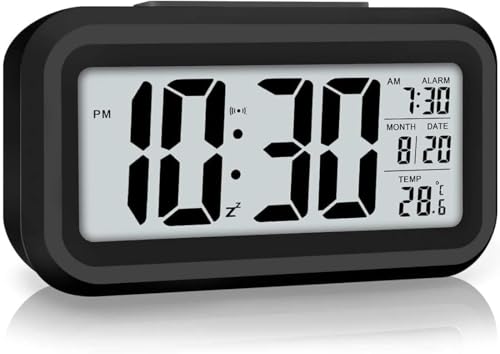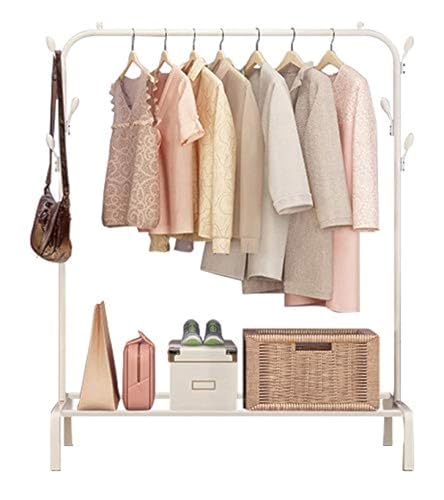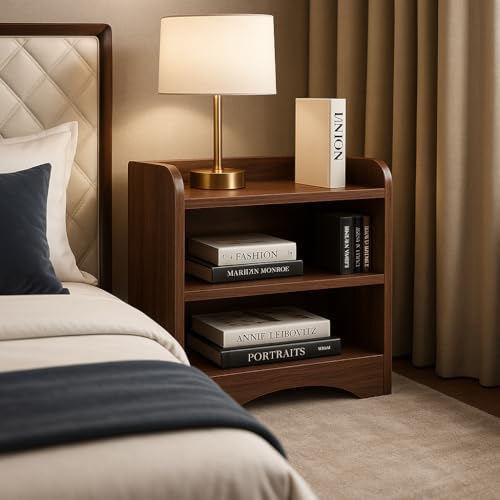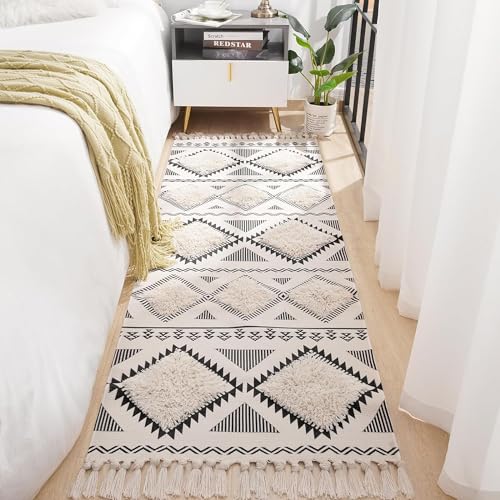Moving into a smaller house or receiving a new family member typically entails getting creative with your space. I recall when my cousin moved to the city—his studio was so tiny that his living room had to function as his sleeping quarters.
It was overwhelming at first, but with the correct approach, he created a space that felt like home. Converting your living room into a bedroom isn’t simply about putting a mattress into your recreational space.
It’s about deliberate planning, clever furniture selections, and establishing zones that serve several tasks without seeming cluttered or chaotic. Whether you’re downsizing, hosting guests, or simply reinventing your home layout, this transition is absolutely feasible with the appropriate strategy.
1. Understanding Why You Need This Change

Before diving into furniture shopping or rearranging, take a moment to identify your personal demands. Are you transforming this space temporarily for a visiting relative, or is this a long-term living situation?
Maybe you’re renting out a bedroom and need to claim the living room as your own retreat. Each scenario necessitates various solutions. Temporary setups could work great with an inflatable mattress and a folding screen, but permanent arrangements need more investment in excellent convertible furniture.
Think about who will use this space and how often. A teenager needs seclusion and storage for clothes and devices, whereas a guest room conversion can focus more on comfort and less on everyday functioning.
Write out your must-haves versus nice-to-haves—this list becomes your roadmap. Understanding your “why” helps you make smarter judgments that you won’t regret three months down the line when you’re stumbling over misplaced furniture.
2. Mapping Out Your Available Space
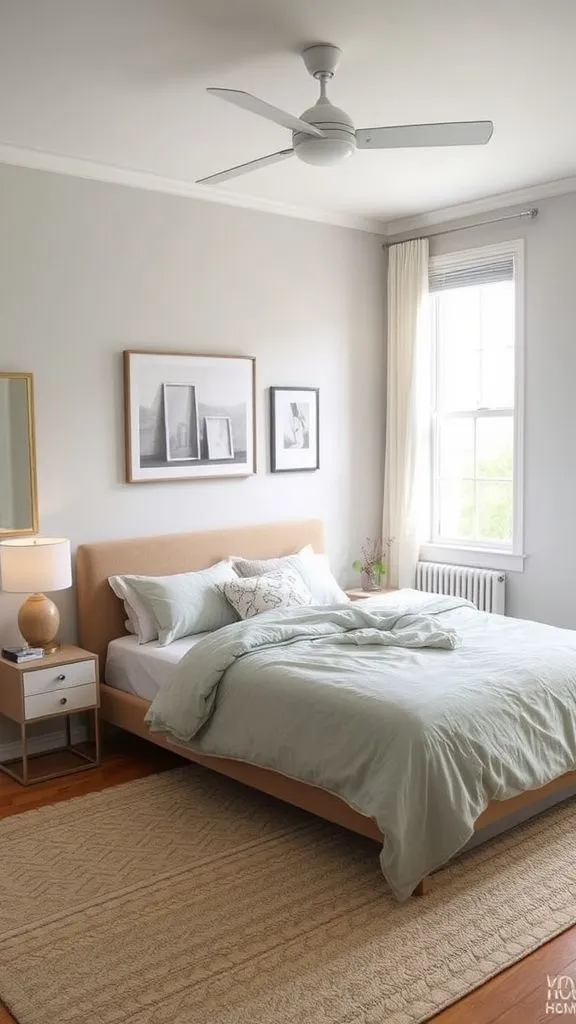
Grab a tape measure and get serious about learning your room’s size. Measure wall lengths, ceiling height, and the space between doorways and windows. Don’t just eyeball it—those additional inches matter when you’re trying to accommodate a bed frame or bookshelf unit.
Sketch a simple floor design on paper or use free software to visualize several layouts before moving heavy furniture. Identify which walls get the most natural light and which corners feel darker or more secluded.
Notice where people naturally travel through the room—you don’t want your bed blocking the major pathway to the kitchen. Think about electrical outlets too; you’ll need access to plug in lighting, charge phones, and maybe run a fan.
Measure twice, purchase once, as the saying goes. This initial homework saves you from costly mistakes and painful returns.
3. Observing How People Move Through the Room

Traffic flow might sound sophisticated, but it’s really just about seeing how you and others organically move around your environment. Spend a day noticing the paths you take most often. Do you cut through the living room to reach the bathroom?
Does the route to your front door cross with where you’d like to place a bed? These patterns matter because nobody wants to jump over furniture every morning. Keep primary paths at least three feet wide for comfortable movement.
If numerous people use the room, investigate how everyone’s routines overlap or conflict. Morning restroom dashes, late-night snack runs, and early alarms all affect location considerations.
Sometimes the “obvious” place for a bed turns out to be the worst choice after you take in real everyday mobility. Trust what you observe above what looks nice in theory.
4. Checking Light Sources Throughout the Day
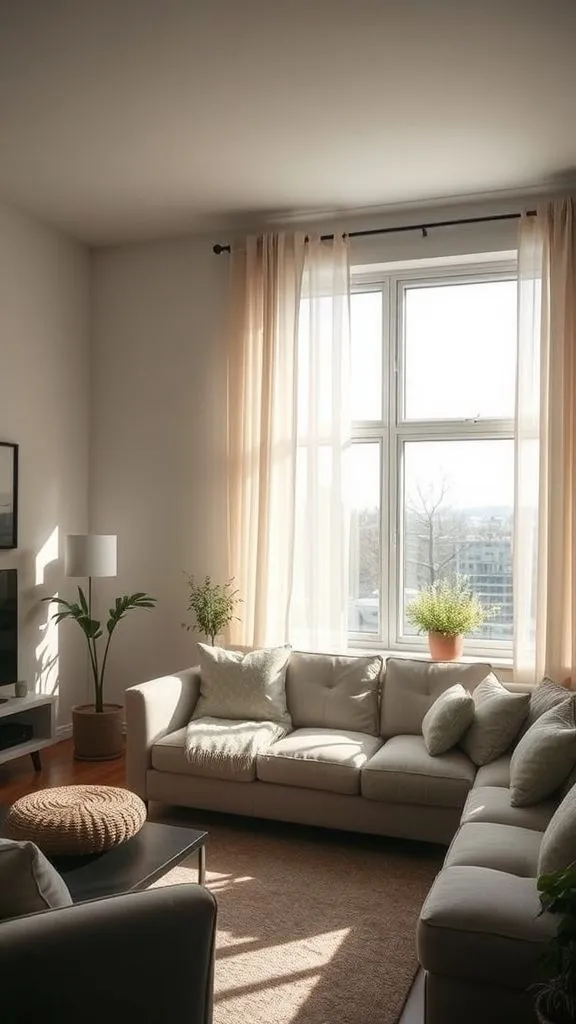
Light alters a room’s mood and functionality. Spend time in your living room at different hours—early morning, midday, and evening—to study how natural light enters and changes. A site that feels sunny and joyful at noon could become dreary and sad by 4 PM during winter months.
Note which windows get direct sunlight and when. Too much morning sun assaulting your face could make sleeping in hard, while a darker spot could feel snug for the evening but dismal during the day.
Consider how drapes or blinds can reduce harsh light without making the area feel like a cave. Skylights, adjacent streetlights, or automobile headlights shining through windows all impair sleep quality.
Your sleeping room doesn’t need to be totally black, but you should be able to manage the light levels comfortably. Natural light also affects mood—make sure your daytime living area isn’t sacrificing all the nice windows to allow nighttime napping.
5. The Game-Changing Murphy Bed

Murphy beds have come a long way from the bulky wooden boxes of the past. Modern versions fold effortlessly into attractive cabinets or shelving units that seem like conventional furniture when closed. This option genuinely gives you a full living room during the day and a proper bedroom at night.
Installation needs some wall reinforcing and professional help, but the return is worth it for permanent conversions. Prices range from a few hundred to several thousand dollars, depending on quality and features.
Some incorporate built-in desks, storage cubbies, or even sofas linked to the bed frame. The everyday practice of taking down and folding up becomes second nature after a week. Make sure you buy a comfy mattress—don’t skimp just because it folds.
Test the mechanism before buying; some work nicely with one hand while others need real muscle. Murphy beds function best against a wall that doesn’t have heat vents or electrical panels behind it.
6. Versatile Sofa Beds and Futon Options
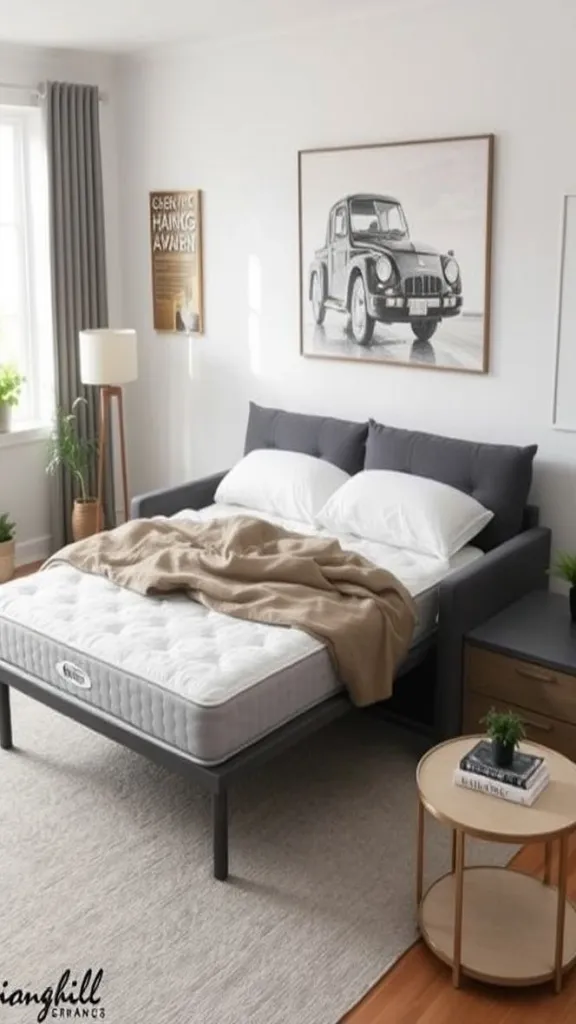
Sofa beds enable the shortest changeover between living and sleeping modes, literally unfolding in seconds. Quality matters significantly here—cheap futons with thin mattresses leave you sore and irritated.
Invest in a well-constructed couch bed with a sufficient mattress thickness, ideally six inches or more. Modern designs look nothing like the enormous eyesores from the ’90s; you can get sleek, attractive selections that suit any environment.
The downside? You’ll make and unmake this bed daily, which gets tedious. Also, you’ll need space in front of the sofa for the bed to stretch, so incorporate that into your floor design.
Futons offer a more relaxed vibe and tend to be lighter and easier to move if you rearrange frequently. They work nicely for younger folks or transient situations. Consider a futon with a hardwood or metal frame rather than all-fabric for increased durability.
7. Stylish Daybed Arrangements
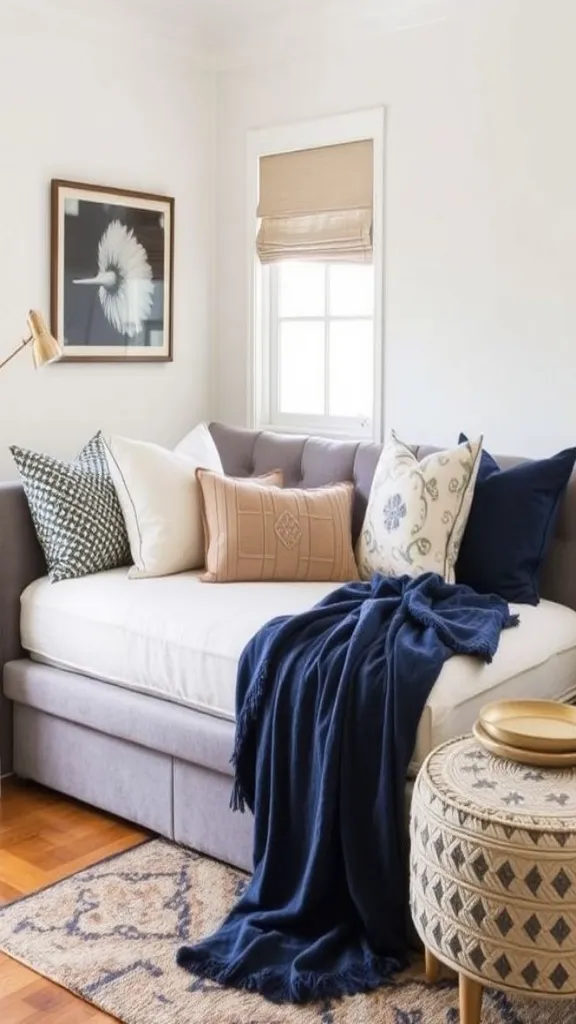
Daybeds cleverly blur the barrier between sofa and bed, acting as both without requiring any conversion. During the day, layer them with attractive pillows and they read as classy seating. At night, clear the cushions, and you’ve got a pleasant sleeping surface.
They work especially well in compact areas since they hug the wall like a couch, taking up less visual and physical space than a traditional bed thrusting into the room. Many daybeds contain built-in trundles underneath, offering you a guest sleeping without compromising floor space.
Style them with throw blankets and intriguing textures to enhance the living room ambiance. The primary limitation? They’re normally twin or full-sized, so couples could feel crowded. Daybeds with backs and sides also give a comfortable, nest-like sensation that some people adore for sleeping but others find confining.
8. Temporary Solutions: Air Mattresses and Floor Beds

Sometimes you just need a fast, budget-friendly solution without commitment. Modern air mattresses with built-in pumps inflate in minutes and can be surprisingly pleasant with suitable mattress toppers. They absolutely disappear during the day when deflated and stashed inside a closet.
This works nicely for temporary situations or guest accommodations. The downside? Nightly inflation and deflation get boring fast, and even great air mattresses develop leaks eventually. Floor beds—Japanese-style futons or simple mattress-on-floor setups—offer another minimalist alternative.
They’re surprisingly comfy for numerous people and highly space-efficient. Just roll up the mattress or fold the futon throughout the day and store it vertically. Floor sleeping isn’t for everyone, especially those with back difficulties or mobility issues. Consider your health needs honestly before committing to sleeping low.
9. Installing Practical Room Dividers
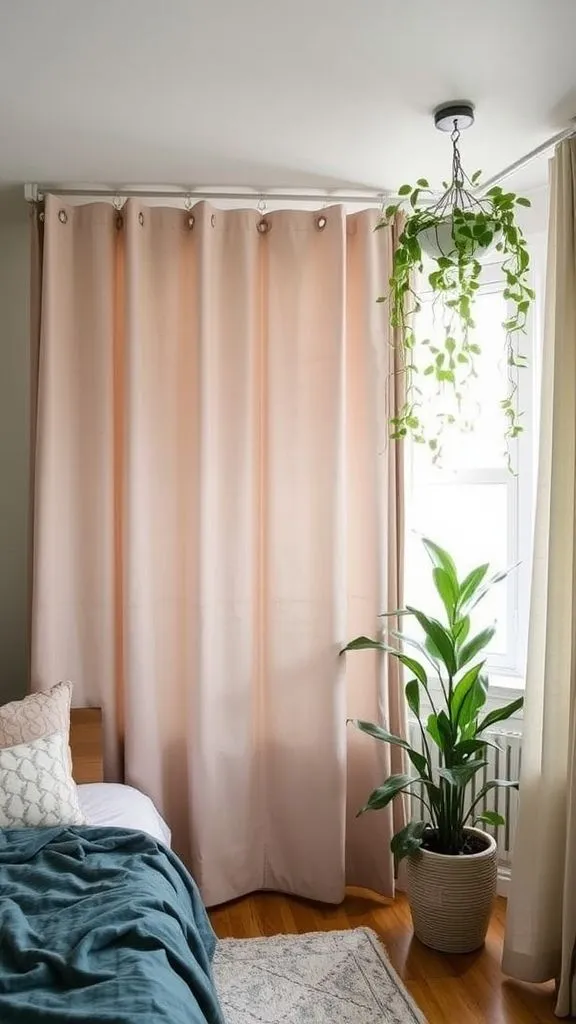
Privacy counts, even in small areas. Room dividers offer psychological and physical isolation between your sleeping and living zones. Options range from cloth drapes on ceiling tracks to folding screens to bookshelf dividers.
Curtains give the most flexibility—you may pull them entirely aside when you want an open room or close them for seclusion and darkness. Choose blackout curtains if light control is crucial. Folding screens offer ornamental flair and move easily, yet don’t block sound.
Tall bookshelves work double duty as dividers and storage; however, they feel more permanent. Hanging plants from the ceiling creates a natural, living partition that softens rough edges.
Even a carefully placed tall plant in a pretty planter might signify a boundary. Whatever you choose, be sure it doesn’t make the area feel smaller or tighter. The goal is definition, not suffocation.
10. Smart Furniture Positioning Strategies
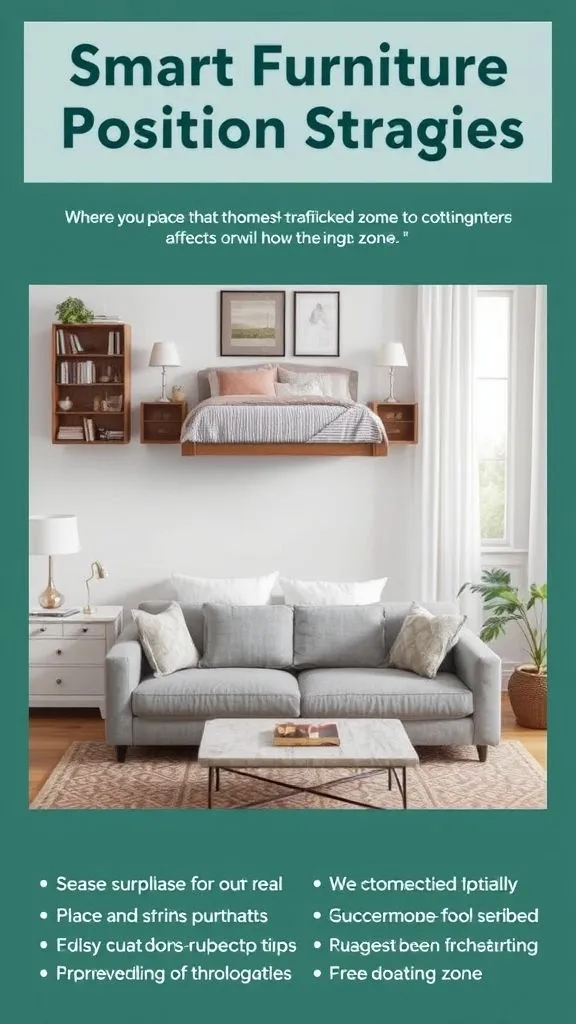
Where you arrange your bed and other furniture drastically affects how the room performs. Positioning the sleeping room in the least-trafficked corner maintains the main living zone. Angle furniture to establish distinct zones—your sofa facing away from the sleeping area helps mentally separate the locations.
Use the back of a bookshelf or dresser as a natural divider. Keep taller objects against the walls to maintain sight lines through the center of the room. Avoid shoving all furniture against walls; floating items can actually make spaces appear larger and more intentional.
Make sure bedroom furniture doesn’t block windows or heating vents. Consider the view from your bed—waking up to a blank wall feels different than seeing a window or artwork. Traffic should flow around, not through, your sleeping zone. Experiment with numerous combinations before settling; occasionally, unexpected layouts work best.
11. Maximizing Under-Bed Storage Space
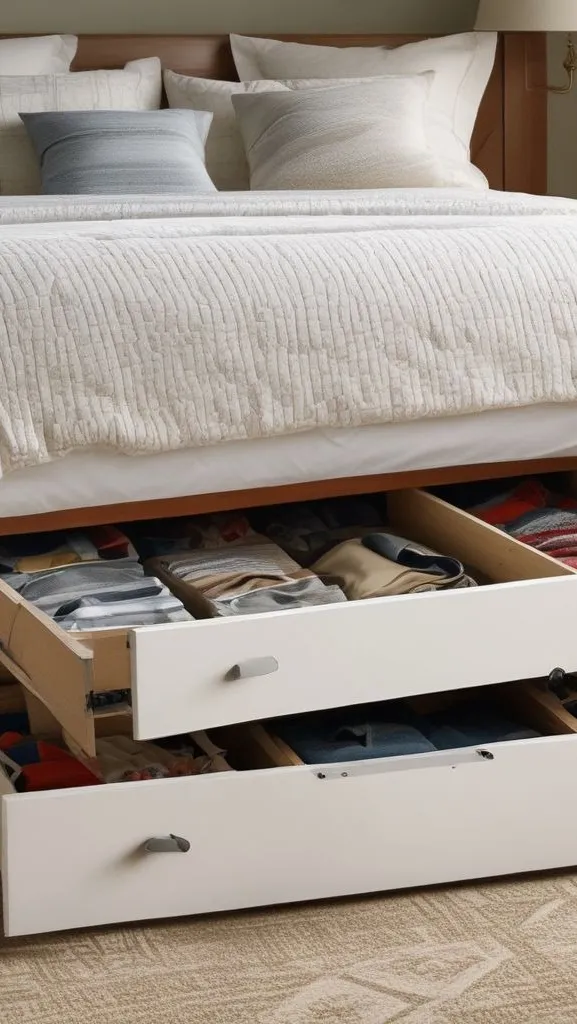
The area beneath your bed is valuable real estate for storage—don’t waste it. Choose beds specifically constructed with storage drawers or hydraulic lift systems that reveal vast compartments. For mattresses without built-in storage, add rolling bins or flat boxes that glide smoothly.
Store seasonal apparel, spare bedding, or rarely used items down there. Use vacuum-sealed bags to compress bulky goods like winter coats or comforters. Label everything clearly so you’re not hauling out five cartons to find one item.
Keep the goods you require most frequently toward the front for easier access. If you’re utilizing a Murphy bed, the vertical space when it’s folded becomes available for storage—use it wisely. For air mattresses or floor beds, consider a low platform with built-in drawers underneath.
Under-bed area that’s well-organized doesn’t become a dust-collecting rubbish zone. Just remember to leave access for cleaning—dust bunnies multiply under mattresses.
12. Thinking Vertically for Storage
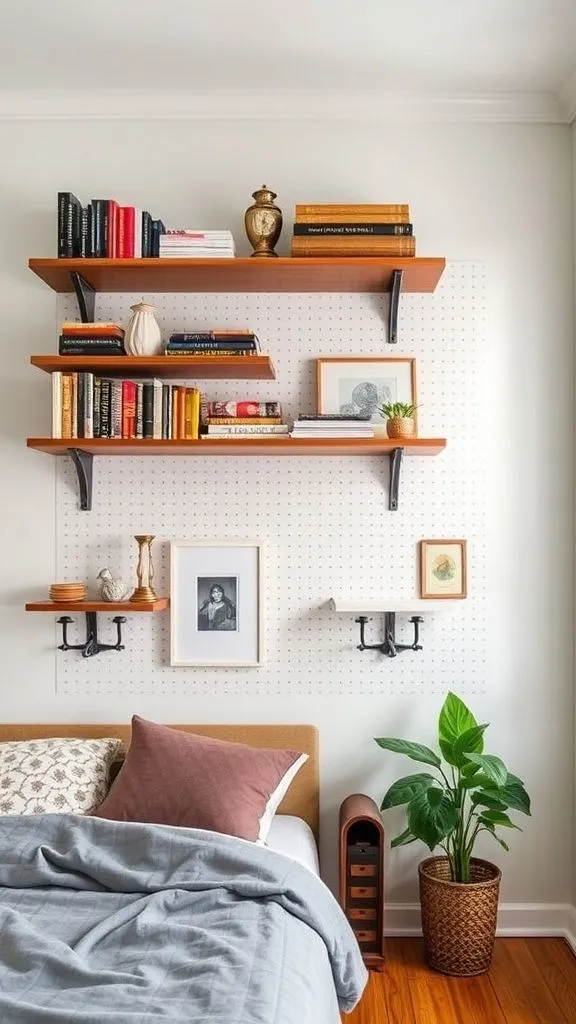
When floor space is limited, look skyward. Wall-mounted shelves, tall bookshelves, and overhead cabinets drastically boost storage without eating into your living area. Install floating shelves above your bed for books, alarm clocks, and ornamental accessories.
Use the full height of your walls—there’s sometimes wasted space between where furniture finishes and the ceiling begins. Pegboards aren’t only for garages; they enable versatile, customized storage for everything from headgear to tiny plants.
Hanging organizers on doors provides areas for shoes, accessories, or cleaning items. Corner shelves optimize difficult angles that generally go unused. Wall hooks hold bags, coats, or even folded chairs.
If you’re renting and can’t place holes in walls, tension rods between walls or in corners can support lightweight storage. Vertical storage keeps goods accessible while retaining clear floor space, which helps any room feel larger and breathable.
13. Investing in Multi-Functional Furniture
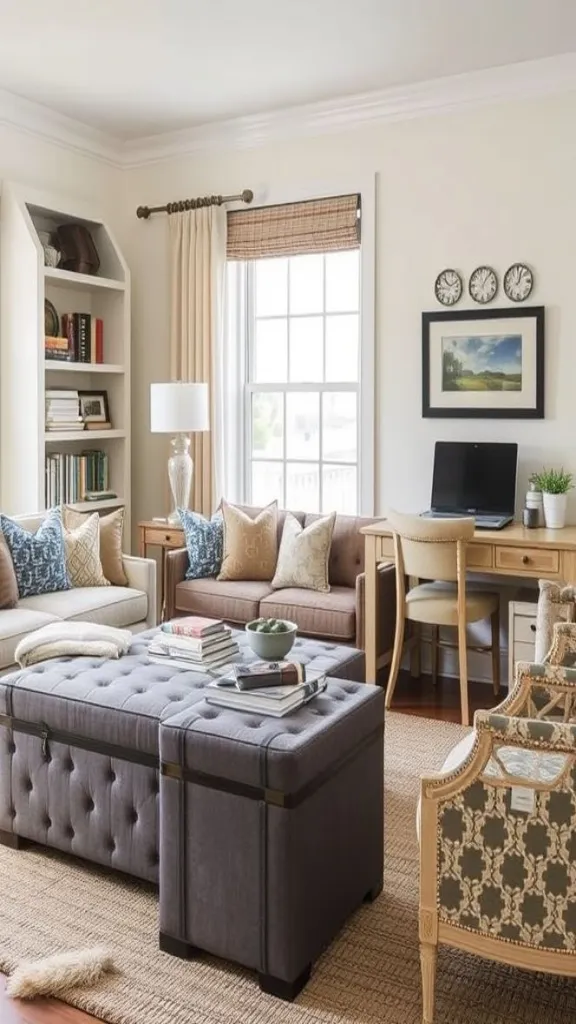
Every item of furniture in a dual-purpose room should earn its space by providing several roles. Storage ottomans feature seating, footrests, and hidden compartments. Nesting tables tuck away when not needed. Fold-down desks attach to walls and disappear when you’re done working.
Trunks act as coffee tables while storing blankets or games inside. Benches with lift-up seats line walls and hide clutter. Even attractive baskets on shelves manage goods stylishly. Choose coffee tables with bottom shelves or drawers rather than single-surface versions.
Select nightstands with many drawers rather than open styles. A small cart on wheels can function as a nightstand, workspace, or serving station, depending on the time of day. Before buying any furniture, ask yourself: “Does this serve at least two purposes?”
If the answer is no, rethink if it belongs in your space. Multi-functional items cost more upfront but deliver far better value.
14. Creating Layered Lighting Options
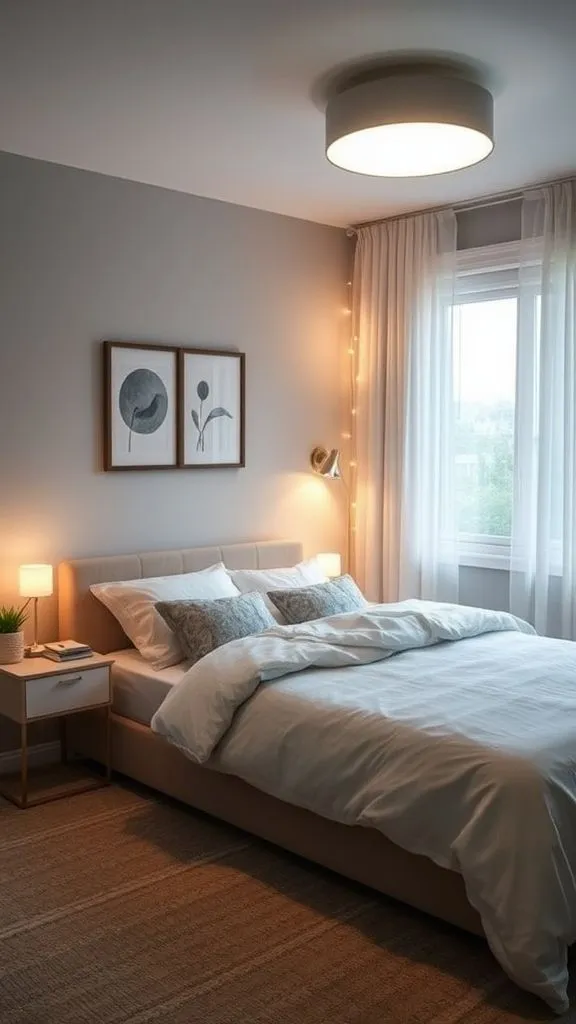
One ceiling light won’t cut it when your room offers two unique roles. Layered lighting means blending ambient, task, and accent lighting for varied moods and activities. Overhead lights or ceiling lighting provide general illumination for daytime living activities.
Table lights or wall sconces near your sleeping space offer softer, adjustable light for reading in bed. Consider installing dimmer switches so you may control the light throughout the day. Floor lamps placed strategically enlighten specific zones without dominating the whole space.
String lights or LED strips offer atmosphere and can function as soothing nightlights. During the day, you might prefer bright, invigorating light for work or pastimes. In the evening, warmer, dimmer lighting helps your body prepare for sleep.
Avoid intense blue-white LED lighting in sleeping areas—they interfere with natural sleep cycles. Instead, consider warm-toned bulbs at 2700K-3000K.
15. Embracing Smart Lighting Technology
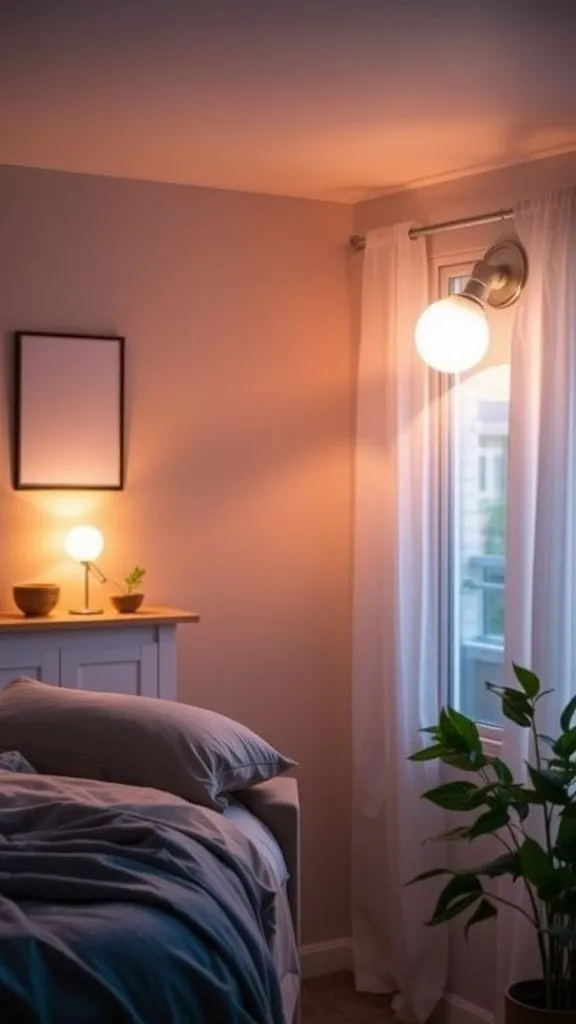
Smart bulbs and lighting systems enable you to manage brightness, color, and timing from your phone or with voice commands. Schedule lights to gradually lighten in the morning, emulating sunlight to help you wake naturally.
Set nighttime routines that automatically reduce lights as bedtime approaches. Create different lighting situations for different activities—bright and cool for working, warm and dim for resting, entirely off for sleeping.
Motion sensors switch on nightlights automatically when you get up at night, minimizing stubbed toes and maintaining sleepiness. Smart lights don’t require separate fittings; they screw into standard lamps and overhead lights.
The initial outlay feels steep, but the convenience and energy savings build up. You can also control lights remotely, turning them on before reaching home so you’re not entering darkness. Some systems interact with sleep-tracking apps to modify your environment for greater rest.
16. Establishing Smooth Morning Routines
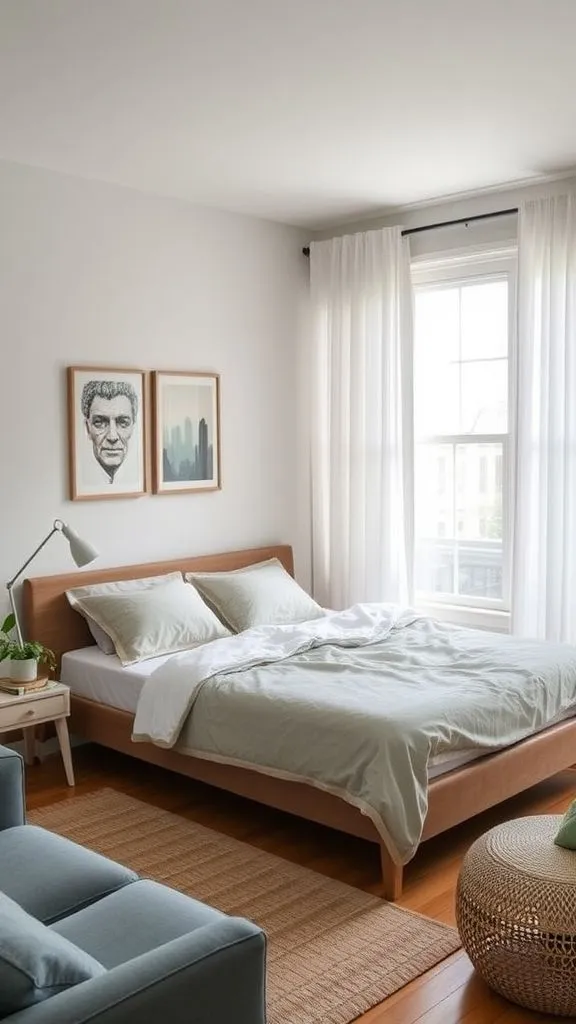
Living in a dual-purpose space takes discipline with daily routines. Develop a morning regimen that changes your bedroom back into a living room effectively. If utilizing a convertible bed, fold or convert it soon upon waking—don’t let it sit out all day.
Put away pajamas, tidy sheets, and put pillows into storage boxes. Open drapes or blinds to bring in natural light and refresh the space. A fast five-minute morning routine stops your living room from seeming perennially bedroom-ish.
Keep a small basket or bucket for bedtime necessities (phone charger, book, glasses, etc.) that you can swiftly store in a closet. Make your bed correctly, even if it’s a couch bed—it sets the tone for the place.
Air out the room by opening a window temporarily. Morning habits feel tedious initially, but become instinctive within a week or two. Future, you will appreciate starting each day with a tidy, efficient space.
17. Preparing Your Space Each Evening

Evening preparation helps you wind down while establishing a comfortable sleeping environment. Close drapes or blinds for privacy and light control. Convert your couch bed or bring down your Murphy bed when you’re still alert—don’t wait until you’re exhausted.
Set out everything you’ll need in the morning so you’re not stumbling about in the dark. Adjust the thermostat or fans to your ideal sleeping temperature. Put away any work materials or daytime clutter that can distract you or produce visual noise.
Dim lights approximately an hour before bed to inform your body it’s time to relax. Perhaps brew some herbal tea or conduct gentle stretching as part of your wind-down ritual. Evening habits create psychological boundaries between your hectic day and tranquil night.
Even little rituals—like lighting a candle you extinguish before bed—mark the transformation. Consistency counts more than perfection; just make it happen most nights.
18. Controlling Temperature and Air Quality

Temperature strongly influences sleep quality, and living rooms generally have distinct temperature difficulties from bedrooms. Living rooms often have larger windows and higher ceilings, which can make them difficult to heat or cool efficiently.
Invest in a nice fan or portable heater that you can relocate as needed. Keep your sleeping environment at 60-67°F (15-19°C) for optimal rest—most individuals sleep best on the cooler side. Use window treatments that insulate; thermal curtains stop drafts in winter and heat in summer.
A little humidifier helps if your home is too dry, especially with forced-air heating. Air purifiers filter out dust, allergens, and odors that collect in multi-use environments. Consider a white noise machine or fan to hide street noise or domestic sounds.
If your living room connects to a kitchen, cooking scents can affect sleep—proper ventilation counts. Plants not only look attractive but also organically improve air quality. Pay attention to how your body responds to varied settings and adjust accordingly.
19. Managing Noise Disruptions

Noise creates distinct issues when your bedroom is also a main living space. If you share a home with others, create quiet hours for evenings and mornings. Explain your circumstance so folks understand they’re walking past a sleeping place. Use rugs and carpets to soften footsteps and sound transmission.
Heavy drapes absorb sound in addition to obstructing light. Door draft stoppers prevent noise bleeding in from adjoining rooms. White noise devices, fans, or sleep applications cover bothersome sounds like traffic or neighbors. Earplugs work in a pinch but aren’t great long-term.
If you’re working from home in the same environment, define boundaries regarding when “bedroom mode” begins—no loud calls or music after a particular time. Address noise at its source as much as possible; replace squeaky doors, oil hinges, and tighten loose fittings.
Noise-canceling headphones allow you to escape when you need quiet for reading or relaxing. Living in a multi-functional area needs discussion and compromise among household members.
20. Accommodating Overnight Guests
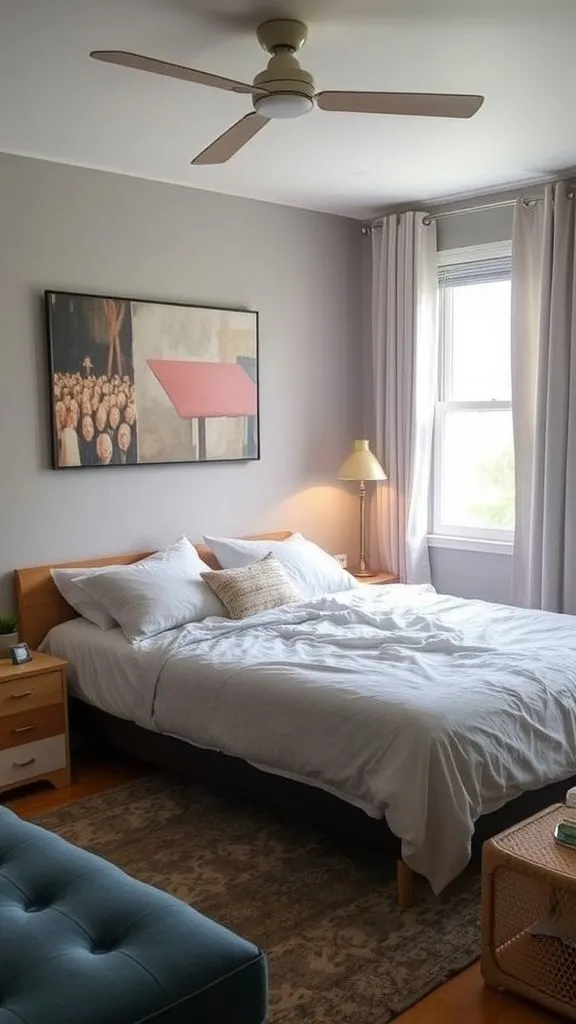
Having overnight guests when your living room is your bedroom demands extra forethought. If feasible, recover your original bedroom temporarily and sleep on the convertible furniture yourself—guests enjoy genuine beds. If that’s not possible, build up a separate sleeping place utilizing an air mattress in another corner or room.
Provide guests with privacy by offering them the convertible bed and sleeping elsewhere yourself. Give them storage space by clearing a piece of closet or shelf specifically for their usage. Supply new sheets, extra blankets, and clear locations for their possessions.
Establish bathroom schedules to prevent morning confrontations. Stock guest essentials like phone chargers, bottled drinks, and extra towels. Be transparent about your living conditions so guests understand the space limits and can adapt their expectations.
Most people are very understanding when you communicate openly. Brief visits work better than extended stays in cramped quarters—be honest about your capacity to host comfortably.
21. Keeping Your Dual-Purpose Room Clean

Cleaning is more vital and more complex when one area serves many roles. Daily tidying stops mess from multiplying—five minutes morning and evening keeps chaos at bay. Weekly deep cleaning includes vacuuming under and around furniture, wiping surfaces, and renewing bedding.
Designate spaces for everything so items don’t pile up haphazardly. Use baskets, containers, and drawer organizers to preserve order. Living and sleeping in the same space means more dust, hair, and general garbage gathering.
Vacuum your mattress or couch bed monthly to remove dust mites and allergens. Wash bedding weekly in hot water. Keep cleaning products accessible but stored correctly. Address spills and stains immediately before they set.
Open windows periodically to circulate fresh air and prevent stuffiness. A tidy space actually enhances sleep quality and daily mood. Don’t let tiny messes pile into enormous projects. Schedule cleaning times just like you would any other appointment.
22. Evaluating What’s Working and What Isn’t
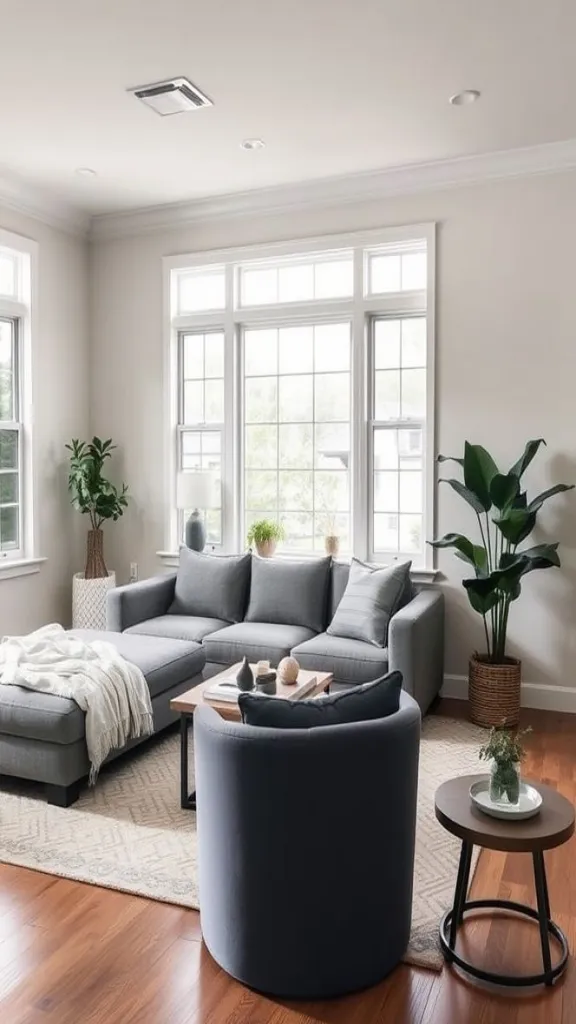
Every few months, honestly assess how your living room bedroom is operating. Are you continuously frustrated by some aspects? Does anything seem awkward or inconvenient daily? Maybe that furniture arrangement seemed wonderful at first, but now it inhibits too much movement.
Perhaps your storage system isn’t actually operating, and stuff piles up regardless. Write down specific problems before shopping for solutions—you’ll make better selections. Ask yourself what you’d alter given an unlimited budget, then work out inexpensive versions of those enhancements.
Notice what you never use; that pricey room divider collecting dust could be returned or repurposed. Pay attention to your attitude and energy—does the place uplift you or drain you?
Sometimes, little modifications like adjusting lighting or adding plants make tremendous differences. Other times, you need bigger adjustments. Regular assessment reduces long-term discontent and helps you adapt as your demands grow.
23. Choosing Quality Over Quantity

When budget allows, invest in fewer, better-quality pieces rather than overloading your area with inexpensive options. A well-made sofa bed that lasts ten years trumps three cheaper models that break within months.
Quality mattresses greatly improve sleep and health—they’re worth proper investment. Well-constructed storage furniture withstands daily usage without breaking apart. Better fabrics look finer and keep their appearance despite wear.
Good hardware on convertible furniture performs properly year after year. Cheap items often cost more long-term through replacements and dissatisfaction. Save up for products you’ll use daily rather than buying everything immediately.
Start with the necessities done right, then gradually add accessories. Quality doesn’t always equal pricey; occasionally, smaller brands offer better value than big labels. Read reviews carefully, especially for convertible furniture and storage solutions.
Visit stores to evaluate furniture physically—sit on sofas, pull out beds, open drawers. Ask about warranties and return policies.
24. Prioritizing Your Personal Comfort
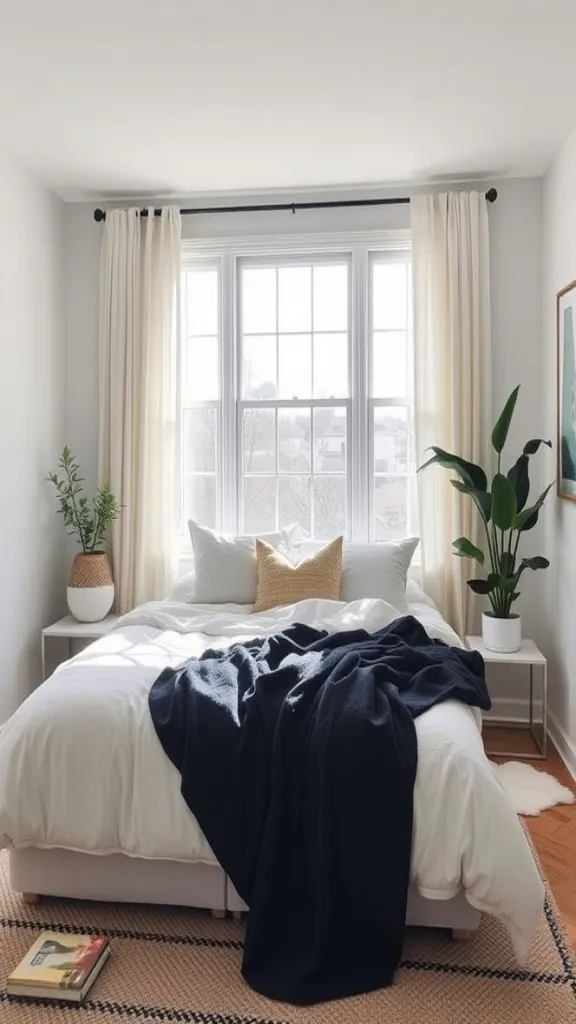
Ultimately, this is your home and your space—design it for your actual requirements, not Instagram looks. If you sleep better with complete darkness, invest in great blackout curtains even if they’re not trendy. If you love waking to natural light, put your bed near windows despite customary recommendations.
Hate making beds daily? Choose a daybed with a fitted cover rather than a couch bed requiring full setup. Your comfort matters more than design rules. Consider your individual body needs—firm or soft mattress, numerous or few pillows, warm or chilly sleeping climate.
Honor your routines rather than fighting them; if you always read before sleep, provide decent bedroom illumination. If you need perfect silence, favor soundproofing over an open design.
Work with your natural rhythms rather than forcing yourself into someone else’s perfect arrangement. Your living room bedroom should help your life, not complicate it. When something repeatedly irritates you, fix it—don’t suffer needlessly.
- Wide compatibility: The internal width of the wall mount is 0.9 inches, and…
- No damage installation: strong adhesive (waterproof adhesive) behind the…
- Keep away from radiation: When you sleep at night, please put your cell…
- DIMENSIONS: Compact nightstand measuring 40.6 cm x 25.4 cm x 50.8 cm…
- STORAGE SPACE: Features two open shelves ideal for books, decorative items,…
- CONSTRUCTION: Crafted from durable engineered wood with a rich dark brown…
- Mood Light: A touch-activated table lamp that’s great for relaxing…
- Easy to use with touch control: Just short press the center at the top of…
- Rechargeable USB light: built-in rechargeable lithium battery, usb charging…
- AERYS Alarm Clock 3 batteries required which is not included in package
- AERYS Alarm Clock Package contains: 1 BLACK Digital Alarm clock
- AERYS Alarm Clock Accurate timekeeping: Time, Date , Temperature…
- Durable Iron Frame Construction: Made of premium-quality iron material that…
- 8 Plastic Branch Hooks for Accessories: Features 8 durable plastic branch…
- Spacious Top Hanging Rod: Comes with a strong top rod that can hold…
- ( DIMENSIONS ) With dimensions of 40.6 cm x 25.4 cm x 50.8 cm (16x10x20…
- ( STORAGE SPACE ) With a roomy top surface for lamps or displays, it has…
- ( CONSTRUCTION ) Made from sturdy engineered wood, this piece has a deep…
- EASY TO INSTALL – No need for DIY stress. The ready-to-use hanging shelves…
- UNIVERSAL DESIGN – Dark brown in color, these contemporary hanging shelves…
- EASY TO ADJUST – Whether you need a hanging plant shelf for a living room…
- Furniture Finish: Deco Paint; Assembly Instructions: Diy; Special Features:…
- CONTENT & SIZE: One Piece Bedside Runner,Rug, Size-2×5 feet or 60cms x 152…
- MATERIAL & CONSTRUCTION: Indian Hand Woven Cotton Rug Runner with 100%…
- HAND WOVEN: Absolutely handmade paddle rug is woven by the rural artisans…
[High Quality]: Street27 bench cover is made of 92% polyester and 8%…
[Great Fit]: The jacquard bench cover is available in a variety of…
[Bench Protector]: Classic rhombic lattice jacquard fabric design dress…
FAQs
How much does it cost to convert a living room into a bedroom?
Costs vary greatly depending on your approach. Basic adaptations utilizing existing furniture and basic separators could cost under $200, while high-end Murphy beds with custom installation can surpass $5,000. Most people pay between $500-$2,000 for comfortable, functional setups featuring a nice convertible bed, storage solutions, and privacy aspects.
Can I turn my living room into a bedroom in a rental apartment?
Absolutely! Focus on non-permanent solutions like freestanding room dividers, curtain rods, and freestanding furniture rather than built-in systems. Most landlords don’t mind temporary conversions as long as you don’t damage walls or exceed occupancy limitations. Always review your lease first, and seek renters’ insurance to secure your things.
Will changing my living room lower my home’s value?
Temporary conversions don’t harm house value as they’re reversible. If you’re selling, just transform the space back to a typical living room for showings. Permanent installations like Murphy beds might actually improve value by displaying efficient space utilization, especially in locations where smaller homes are typical.
How can I retain privacy if I don’t have a door?
Room dividers, thick curtains on ceiling tracks, and towering bookshelves make effective privacy barriers without permanent construction. Frosted window films, folding screens, and strategic furniture arrangement can help. For sound privacy, add carpets, soft furnishings, and white noise machines to absorb sounds and create psychological barriers.
What’s the finest sleeping option for long-term use?
For long-term conversions, invest in either a high-quality Murphy bed with a good mattress or a well-constructed couch bed with at least a six-inch thick mattress. Daybeds with comfortable mattresses also work nicely. Avoid relying on air mattresses or cheap futons for more than a few months—your sleep quality and physical health will suffer.
Conclusion
Transforming your living room into a bedroom encourages you to think creatively about every square foot of space. It’s not always simple, especially in those initial weeks when routines feel uncomfortable and the area feels neither a total living room nor an appropriate bedroom.
But with wise planning, quality furniture choices, and regular daily behaviors, you can create a room that actually works for both tasks. Remember that this setup doesn’t have to be forever—it’s a solution for your current situation.
Be patient with yourself as you figure out what works. Adjust things that frustrate you rather than suffering through them. Most essential, make this area feel like home, not just a haphazard setup. Your comfort, rest, and everyday peace matter more than any design magazine’s opinion.
Start with one modification at a time, and before you know it, you’ll have created a cozy, useful room that serves you well both day and night.
Last update on 2 days ago (2025): Affiliate links and Images from Amazon Product Advertising API



